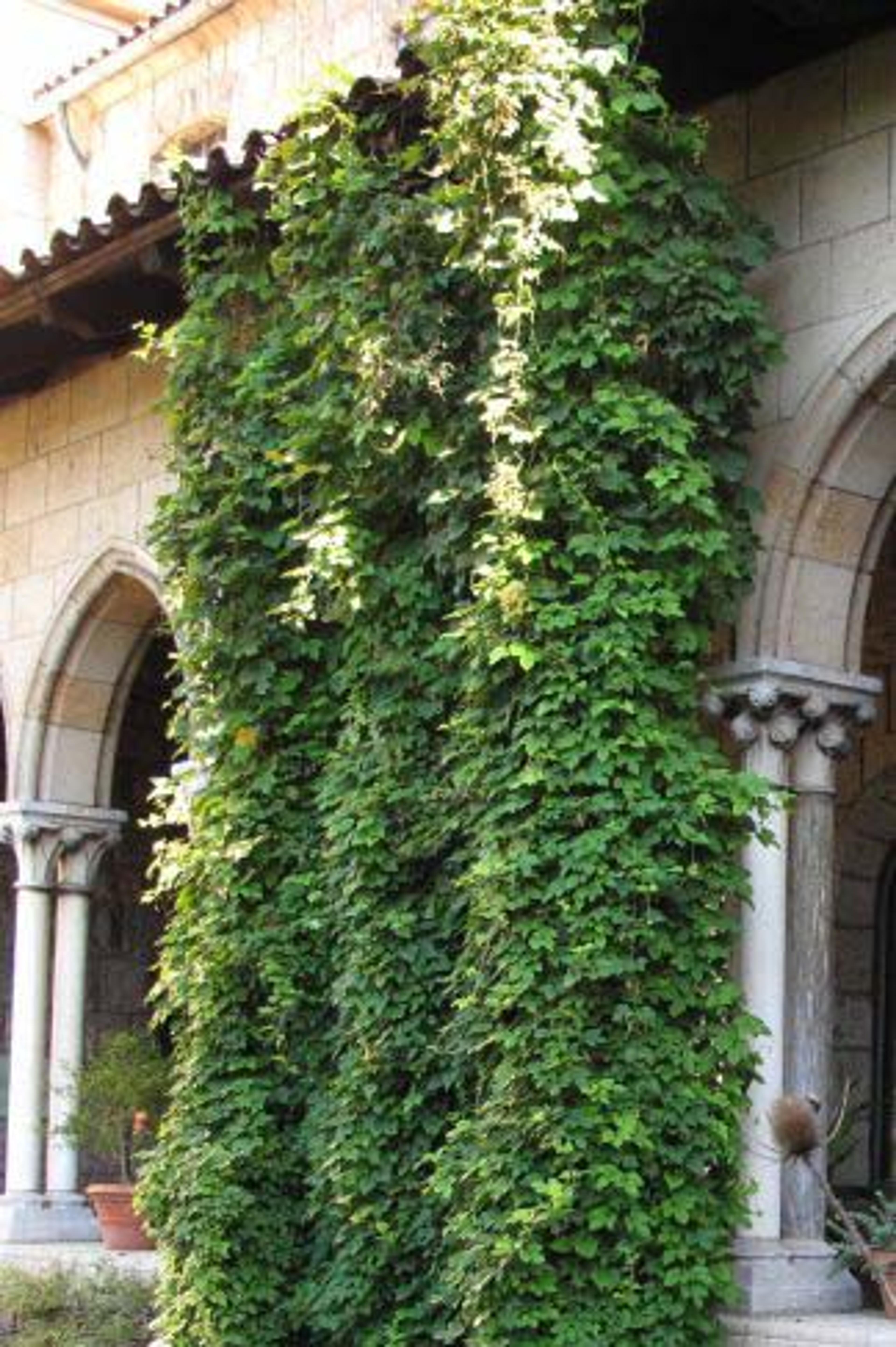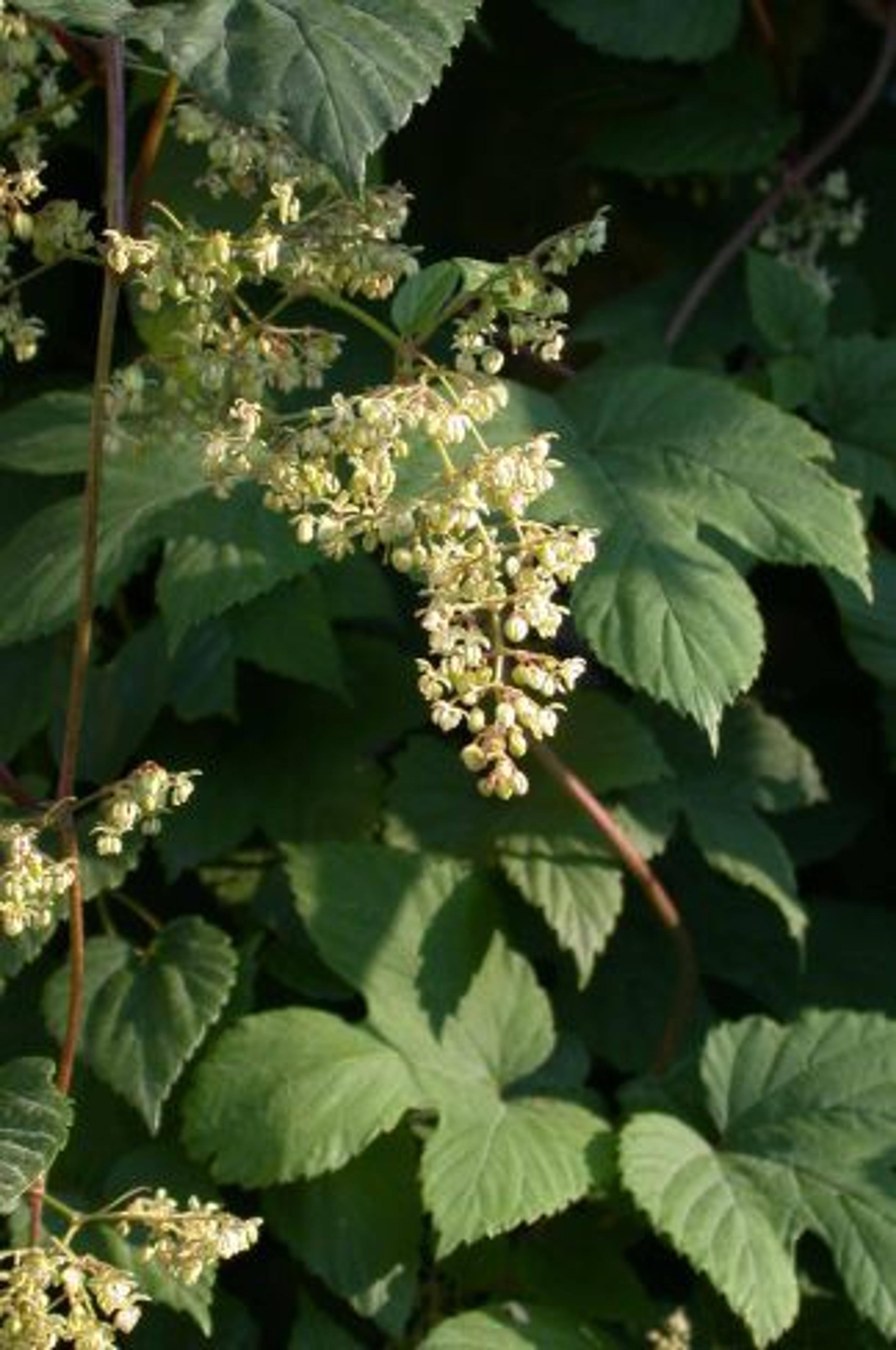The Medieval Garden Enclosed—He-Hop, She-Hop

Hop bines grown in Bonnefont Cloister garden send out new shoots in March, reaching the roofline by the end of May and dying back to the ground in late autumn. The hop bines grown in Bonnefont Cloister are of an unknown variety. While hops were collected from the wild in the earlier Middle Ages, hop plants were under cultivation by the tenth century and have been grown intensively ever since. Many cultivated varieties are now in existence.

Detail of a bine bearing a male flower. The male flowers of the hop blooming in August. Unlike the females, the males do not have aromatic properties. Photograph by Barbara Bell.
Hop (Humulus lupulus) has been used as a vegetable (according to the Roman natural historian Pliny, the young shoots of the plant were eaten), as both fodder and bedding for cattle, as a dye, and, like its close relative hemp (Cannabis sativa), as a fiber plant. It also appears as a medicament in medieval and Renaissance herbals. The fifteenth-century Herbarius Latinus recommends hops for purifying the blood, opening obstructions of the spleen, easing fever, and curing both headache and jaundice. However, the most important economic use of hops in the Middle Ages and at the present writing is in brewing beer. The bitter, aromatic principles of the hop give flavor to the brew, but they are also antimicrobial. This preservative property was well known to the twelfth-century abbess Hildegard of Bingen, who wrote that the bitterness of hops retards spoilage in beverages to which it has been added. [She also deplored the plant's tendency to induce melancholy (Physica, LXI).]

A beautifully rendered hop bine bearing female cones adorns the abacus of a capital in Saint-Guilhem Cloister.
Saint-Guilhem Cloister. French, (late 12th–early 13th century). 30 ft. 2 in. × 23 ft. 10 in. (919.5 × 726.4 cm). The Metropolitan Museum of Art, New York, The Cloisters Collection, 1925 (25.120.1–.134)
In the bed below the parapet wall in Bonnefont Cloister Garden, hop bines twine themselves up hemp ropes strung from a series of metal rings set into the wooden roof beams. The bines have persisted in the same spot for more than fifteen years. They die back to the ground in winter, but vigorous new shoots emerge in early spring, reaching the roofline in a mere six or seven weeks of growth. (The name "hop" is derived from the Anglo-Saxon verb "hoppan," or "to climb.") The plant is dioecious, i.e. the species includes individuals of both sexes, and male and female flowers are produced in August and September. While the plant is referred to in the singular ("hop"), the female flowers are designated as "hops"
Pollinated female cones are no longer viable for brewing purposes, which makes the male plants a nuisance in commercial hop yards. For our educational purposes at The Cloisters, we're happy to grow both sexes. Two years ago, we had both male and female plants in abundance, and I was somewhat mystified that no female flowers developed either last year or this year. Our bines are basically healthy and vigorous, although they do suffer damage from mites and mildews in summer, and it seemed odd that all of the female bines would have died back or been crowded out by the males, who continued to flourish.
This made me wonder: Can hops change sex? I visited an online forum for home brewers and discovered that other growers found themselves in the same situation. One of them had consulted a commercial hop supplier who claimed that it was indeed possible for hop plants to change gender in response to stress, but according to Dr. John Henning, a plant geneticist who heads the USDA-ARS Hop Breeding & Genetics Program based at Oregon State University, this is not a scientific explanation. Dr. Henning thinks it more likely that the females of the unidentified hop strain we're growing (our bines were acquired from a commercial herb grower who did not specify the cultivar) were more susceptible than the males to insect damage and disease. Both the male and female plants die back to the ground after the first frost, and we can't determine whether the young shoots that emerge in spring are male or female. Only when the bines flower again in late summer can we know if both sexes have survived. Now we know that we'll need to plant new stock, and Dr. Henning, who maintains a germplasm bank that includes many cultivated forms of hop, including antique strains that might be closer to the medieval type than modern varieties, has kindly offered to help us by providing an appropriate strain.
References
Andersen, Frank J. Herbals Through 1500. New York: Abaris Books, 1984.
DeLyser, D. Y. and W. J. Kasper. “Hopped Beer: The Case for Cultivation.” Economic Botany, Vol. 48 [2] (1994). New York: The New York Botanical Garden, 1994.
Throop, Priscilla, transl. Hildegard von Bingen’s Physica: The Complete English Translation of Her Classic Work on Health and Healing. Rochester, VT: Healing Arts Press, 1998.
Deirdre Larkin
Deirdre Larkin is the managing horticulturist at The Met Cloisters museum and gardens.